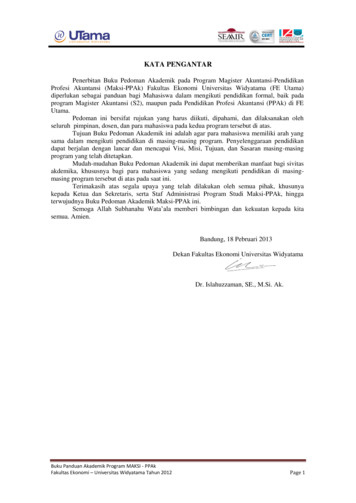AIChE 2015 Hybrid Distillation Membrane Process
Hybrid Distillation – Membrane Processto Increase Capacity and Reduce Costsfor Production of Propylene and EthyleneSudip Majumdar, Yosuke Koizumi, Ken Loprete,Evan Sohodski, Ken Pennisi, Stuart NemserCompact Membrane Systems, Wilmington, DEwww.compactmembrane.comAIChE Annual MeetingSalt Lake City, UT, November 8-13, 2015AIChE 20151
Overview Opportunity for Olefin-Paraffin Separation 30 Year Membrane History CMS Stable Facilitated Transport Membrane Preliminary Scale-Up Engineering and Economic Evaluation Path ForwardAIChE 20152
Olefins are BigChemicalProduction*(1x106 lbs)Nitrogen / OxygenEthanolEthylenePropyleneAmmoniaChlorine / Sodium HydroxideEthylene DichlorideBenzeneEthylene OxideAcetone69,600 / 58,30066,10052,90031,10022,70021,500 / 16,60019,40013,3005,9003,200* 2010 Production of top 10 chemicalsAIChE 20153
Ethylene and Propylene Product ChainsAIChE 20154
Membrane Can TouchOlefins Multiple Times Refinery( New on Purpose Propylene Sites) Polymer Purge Line Polymer SiloAIChE 20155
Experimental Upper Bound Based on PurePropylene and Propane Permeation DataRef: Burns and Koros, Journal of Membrane Science, 211, 299 (2003)AIChE 20156
Historically Membranes forOlefin-Paraffin are Not StableRef: Merkel et al., Journal of Membrane Science 447, 177 (2013)AIChE 20157
Commercial Amorphous FluoropolymersTeflon AFCytopAIChE 2015Hyflon8
Facilitated Transport(Fixed Carriers)CarrierOlefinParaffinFacilitated TransportSolution-Diffusion9Adapted from Cussler E.L.: Facilitated Transport. In: Membrane Separation Systems, vol. 2, US DOE Report, DOE/ER/30133-H1 (1990)
Custom Amorphous Fluoropolymer (CAF)and Silver is part of the polymer chain Form stable, high flux, high selectivityfacilitated transport membranes CAF and new synthesis procedurepotentially protects silverAIChE 201510
2500020406080SelectivityPropylene Permeance (GPU)Variation of Humidity100Overall Humidity (%)AIChE 201511
Effect of Feed ConcentrationTop of C3 SplitterPolypropylene Reactor300Bottom of C3 SplitterPropylene Permeance (GPU)4002001000020406080100Propylene Feed Concentration (Vol%)AIChE 201512
Stable, Strong Performance Over Time300C3H6 Permeance (GPU) /C3H6-C3H8 SelectivityLong Term Stability in Presence of SulfurC3H6 Permeance250C3H6-C3H8 Selectivity200150Selectivity is afunction offeed streamcompositionand rangesfrom 30 -801005001020304050Duration (Days)AIChE 201560708013
Ethylene-Ethane Mixture SeparationOlefin Permeance Paraffin PermeanceSelectivity(GPU)(GPU)Ethylene /Ethane275.53.676.2Propylene /Propane226.53.270.2Feed: 20% Olefin - 80% Paraffin; Feed Pressure: 60 psig; Humidified Feed/Sweep; New MembraneAIChE 201514
Preliminary Membrane Scale-up(47 mm Disc vs. 10 inch Square)10”47 mm Disc 25617.010”Feed: 20% C3H6 - 80% C3H8Feed Pressure: 60 psigAIChE 201515
Permeance and Selectivity Mapof CMS MembranesCMSMembranesAIChE 201516
Engineering and Economic EvaluationAIChE 201517
Key Assumptions:C3 Splitter AnalysisMembrane Permeance (Propylene)Membrane SelectivityFeed PressurePermeate PressureMembrane Replacement RateC3 Splitter FeedstockValue of Splitter FeedPrice of HD05 PropanePrice of PropyleneAIChE 2015100 GPU20110 psia14.7 psia33% per year50% Propylene21 cents/lb24.5 cents/lb60 cents/lb18
Distillation-Membrane Hybrid ProcessesConfiguration 2Configuration 1Vacuum Pump& 2-stage neFeedSuperheaterMembranesCompressorw aftercoolerDistillationColumn99.5% Propylene Membrane separates bottom fractionPermeate recycled to columnVery small increase in flood factor 1%Increases propane purity andpropylene yieldTower 95% PropaneMembrane separates distillateRetentate recycled to columnReduces column top product purity requiredReduces reflux ratio required & savesenergyEnables higher feed flow rate to column forgreater propane & propylene productionAIChE 201519
Membrane Completing Separation of HD10 Propane at Bottomof C3 Splitter with Propylene Capacity of 40,000 Tons per YearPaybackInternal Rate of lectivity7535855089Steam &ElectricityPrice-50% 50%1011Propane/PropylenePrice-20% 20%1213Propane &EnergyPrice-20% 20%1415Feed Value-15% 15%CaseAIChE 201520Payback Period (months)250%
Membrane System for Propylene Recoveryfrom Polypropylene Reactor PurgeAIChE 201521
Base Case EconomicsPaybackMonthsC3 Splitter 11Polypropylene Reactor Purge 8AIChE 201522
Summary / Path Forward CMS Demonstrated Stable Olefin-ParaffinFacilitated Transport Membrane Attractive C3 Splitter EconomicsPayback 15 months Key Next Steps Optimize Process – 2016 Build Larger Membrane Modules – 1H / 2016 Demonstrate at Plants – 2H / 2016 - 2017AIChE 201523
AcknowledgementThe authors gratefully acknowledge the supportof the US Department of Energy through SmallBusiness Innovation Research (SBIR) Awards.AIChE 201524
Hybrid Distillation -Membrane Process to Increase Capacity and Reduce Costs for Production of Propylene and Ethylene AIChEAnnual Meeting Salt Lake City, UT, November 8-13, 2015 . Membrane Separation Systems, vol. 2, US DOE Report, DOE/ER/30133-H1 (1990) 10 Custom Amorphous Fluoropolymer (CAF) and AIChE 2015 Silver is part of the polymer .
mixture: simple distillation, fractional distillation, vacuum distillation and steam distillation. The chosen distillation method and extent of purification will depend on the nature of the mixture, and specifically the difference of the boiling points of miscible liquids. In distillation, the mixture is heated, vaporizing a substance.
picoSpin 45/80: Simple Distillation of a Toluene-Cyclohexane Mixture . Dean Antic, Ph.D., Thermo Fisher Scientific, Boulder, CO, USA. 1. Introduction. There are four basic distillation techniques for separating and purify the components of a liquid mixture: simple distillation, fractional distillation, vacuum distillation and steam .File Size: 699KBPage Count: 14
distillation fractional distillation ideal distillation In today’s experiment, the results of simple and fractional distillation of two liquids (cyclohexane and toluene) with boiling point differences of about 30C o will be compared (Option 1). As an alternative to a fractional distillation, a simple distillation of a cyclohexane and p-
the distillation column. This chapter presents background information for both distillation columns and bond graphs. 1.1 The basics of a distillation column The distillation column is a widely used apparatus used to separate various chemicals, most commonly petroleum products. Historically, distillation has been around for millennia.
case of distillation: cryogenic distillation. Distillation is a very common method used to separate two (ore more) components in a trayed or packed distillation column. Cryogenic distillation columns are operated at extremely low temperatures (80-100oK) to separate the desired component and to "waste" useless component. For a
A hybrid process basically exploits the advantages of pervaporation and distillation, while the negative aspects are minimized. Hybrid systems of different types reduce energy expenditures, make separations that are otherwise difficult and/or improve the degree of separation. Index Terms— Pervaporation, Distillation, Membrane, Hybrid Process.
hollow fiber membrane, the coefficient of performance of the membrane based system is increased to 0.57. 3. MEMBRANE IN DISTILLATION TECHNOLOGY WANG ZanShe et al [P6] had done research for “Applications of membrane distillation technology in energy transformation process-basis and prospect” in 2009.
Menyelenggarakan pendidikan akuntansi yang berkualitas dan berkelanjutan yang mudah diakses dan terjangkau oleh masyarakat luas sehingga mampu berperan aktif dalam mencerdaskan bangsa. 3. Melakukan kegiatan penelitian dan pengembangan ilmu ekonomi khususnya dalam bidang akuntansi dan bisnis yang efisien dan efektif sehingga menghasilkan lulusan bidang akuntansi yang kreatif, inovatif dan mampu .























